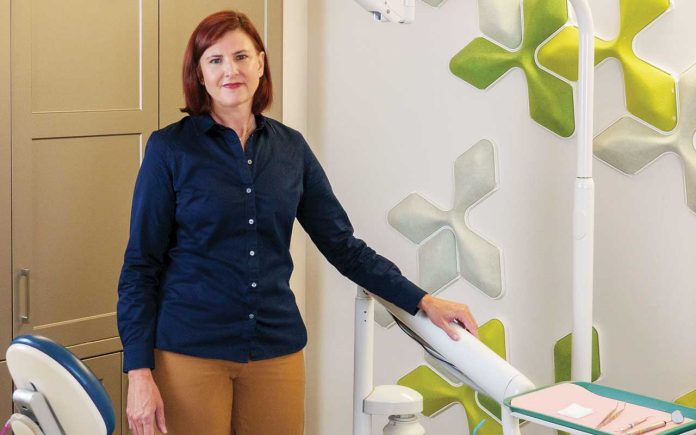Lesley Daigle had just finished giving a speech at a 2024 fundraiser for the Arlington Free Clinic (AFC) when a caterer approached her and pointed to a woman across the room.
“That’s my mother. She was a patient [at AFC] 11 years ago,” the caterer said. “‘She had cancer and she is standing there alive today because of you.”
Daigle had only recently joined the clinic as its CEO, but she says such stories are common at the 31-year-old nonprofit, which provides free medical care for uninsured county residents. In this case, quality health care helped a cancer survivor “provide a good home” for her daughter, Daigle says, putting her daughter on a path to launching her own catering business.
“That is an incredible jump from somebody who couldn’t afford health care,” Daigle adds. “The fact that we can do that for families—that we can lift them up and provide a better life, for not only this generation, but the next generation—is very significant.”
AFC is just one of the local nonprofits offering a lifeline to county residents in need of food, shelter, medical care, job assistance and other vital services. Together, they help make up Arlington’s social safety net.
But many of those same charitable organizations are now in need of a lifeline themselves, in jeopardy of losing—or having already lost—critical funding to support their work.
According to Daigle, AFC and other nonprofit health care providers were already working with strained resources in the wake of the pandemic. Now, looming Medicaid cuts are likely to grow Arlington’s uninsured population. The stress of the moment is also compounding patients’ health problems. Many have chronic conditions that are exacerbated by worries about paying for food, rent and other necessities amid economic uncertainty.
Since January, the Trump administration has unleashed a flood of federal policy shifts and funding cuts that have very real consequences for people facing financial hardship. A freeze on federal grants temporarily stymied rental assistance, early childhood education and other social service programs before it was rescinded. A crackdown on illegal immigration has sparked fear among immigrants, who are disproportionately represented in low-wage jobs. Nonprofits and other federal grantees have been advised to terminate diversity, equity and inclusion programs, some of which support vulnerable populations.
As the year 2025 continued, the president’s tax and spending legislation delivered more bad news for low-income Americans, including significant cuts to food assistance, Medicare and Medicaid. The D.C. region has been hit by federal layoffs, rising unemployment, persistent inflation and business disruptions caused by volatile tariff policies. As of early October, a government shutdown had left thousands of federal workers furloughed without pay.
While they wait for the next shoe to drop, Arlington’s human services nonprofits are scrambling to mend the holes already slashed in the social safety net. Demand for assistance is up, resources are stressed and anxiety is pervasive.
“Every nonprofit in Arlington is going to feel this at some point in time,” Daigle says, whether it’s in the form of slashed grant funding, higher operating costs or a drop in private donors’ ability to give.
“We’re worried about the fallout in the months to come,” she says. “If you asked any nonprofit right now, they would tell you that they feel like resources are contracting at the precise moment that the need for the services they provide is expanding.”
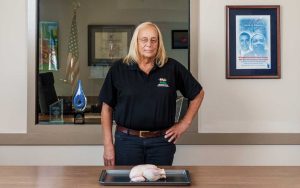
‘A Pattern That is Totally Unusual’
Charitable organizations in the U.S. are about as old as the nation itself. Mutual aid groups, faith-based organizations and medical providers have offered care and community support since the country’s earliest days. Government-led social welfare programs emerged during historic pain points, from the post-Civil War Freedmen’s Bureau to the New Deal initiatives that helped pull the country from the grips of the Great Depression.
Federal support for such programs expanded considerably in the 1960s under the Kennedy and Johnson administrations, with the creation of the Food Stamp Program (now the Supplemental Nutrition Assistance Program, or SNAP); Head Start, which provides early childhood education for low-income families; Volunteers in Service to America (now AmeriCorps); and Medicare and Medicaid, which cover medical care for seniors, people with disabilities and low-income individuals.
Many services are facilitated by nonprofits, which in turn are supported by government grants, contracts and private donations. Most, if not all, of the nonprofits in Arlington County are seeing a rise in need.
The Arlington Food Assistance Center (AFAC), which provides free groceries to qualifying families, has noted an 85% jump in demand over the past five years, according to CEO Charlie Meng. AFAC currently serves about 4,000 families per week, nearly half of whom are beneficiaries of at least one federally funded service.
“If [the safety net] gets cut, we’re going to see more families come to us,” Meng says, “and those families are going to come to us more often.”
Historically, AFAC’s numbers have dipped in the summer when seasonal jobs open up and warmer weather allows for more day labor shifts in fields such as construction and landscaping. But this summer, the number of clients seeking food assistance held steady, prompting Meng to forecast even larger numbers for the fall. In August, he was anticipating some 5,400 families at Thanksgiving. “This is a pattern that is totally unusual in the 18 years that I’ve been at AFAC,” he says.
Faced with higher food prices, AFAC will be distributing Thanksgiving chickens this year in lieu of turkeys. Meng expects that food insecurity will continue to worsen amid the waves of federal layoffs. Many workers received their final paychecks this fall from “fork in the road” deferred resignations. (More than 25,000 Arlingtonians work for the federal government, according to county data.)
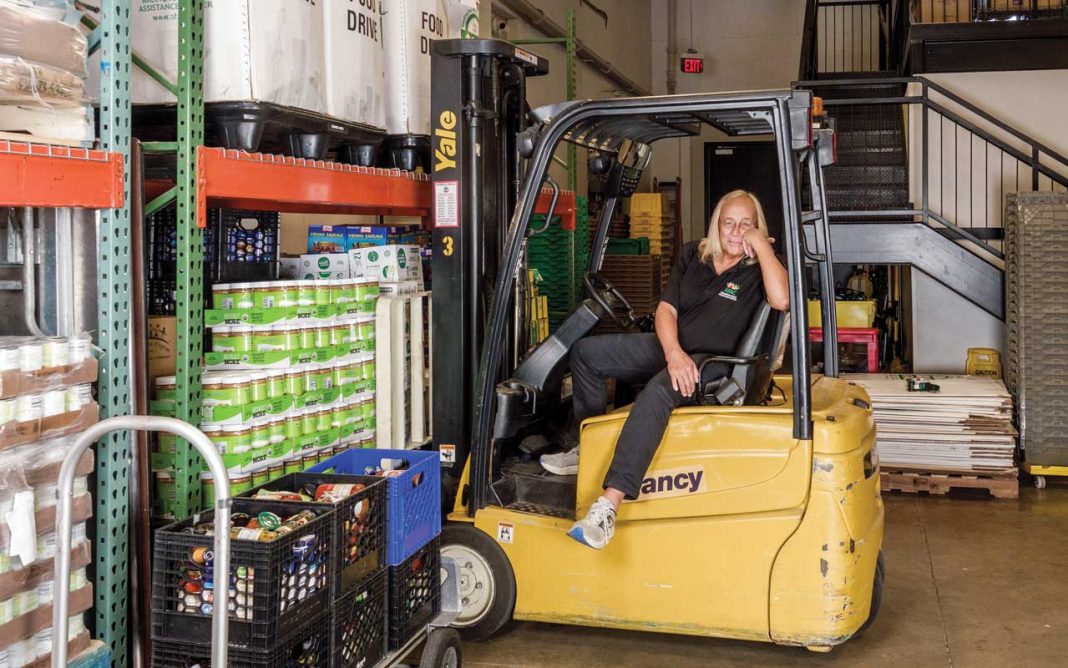
Newly unemployed white collar professionals could be among the new faces at AFAC, but so will the housekeepers, nannies, restaurant workers and others who depended, in part, on those federal employees for their livelihood. When disposable income disappears, cleaning services and dinners out are among the first household expenses to be cut.
Strained Resources
PathForward, a nonprofit that fights homelessness (Arlington Magazine Publisher Greg Hamilton is its current board chair), connects clients with services such as meals and medical care at two Arlington-based shelters, as well as temporary and long-term housing. It’s also seeing a spike in demand. This year’s Point in Time Count, an annual measure of homelessness in the county, showed a 12% rise in homelessness over last year—and a 58% increase since 2021.
Betsy Frantz, PathForward’s president and CEO, expects that number to grow as the impacts of federal layoffs and funding cuts are fully realized. Evictions are still “catching up” to those who owe past-due rent from Covid-era freezes. Meanwhile, Arlington has a chronic affordable housing shortage, and wages aren’t keeping pace with the cost of living. “There are more and more unhoused, so our wait list of people needing services and needing shelter is growing,” Frantz says.
To accommodate higher numbers of individuals seeking shelter this summer, Arlington County asked PathForward to take the unprecedented step of opening its overflow shelter beds early—a move typically reserved for hypothermia season.
“We are seeing people that have food needs, and they don’t know how to handle being on the street,” Frantz says. “They need medical attention, much more so than ever.”
The level of community need may not even be fully apparent amid the nationwide crackdown on illegal immigration. Fear of ICE raids has had a chilling effect on Arlington’s immigrant population, says Brian Marroquín, director of grants and initiatives for the Arlington Community Foundation (ACF). Some immigrants, regardless of their status, are hesitant to leave their homes to access services, and nonprofits don’t have the resources to do home visits.
“Nonprofit folks are really being challenged right now to reimagine how to do more with the same—or less,” says Marroquín. ACF helps individual donors and companies plan and maximize their charitable giving. This year, it created a humanitarian assistance fund that supports immigration-related legal services for low-income Arlington residents.
The Arlington Free Clinic, which treats uninsured adults who don’t qualify for Medicaid, is also approaching capacity, Daigle says. “We consider ourselves the safety net for the safety net.”
Demand at the clinic is likely to grow when Medicaid cuts begin to take effect in 2026. Arlington County was home to 29,307 Medicaid recipients in fiscal year 2024, she says, and another 10,000 are uninsured.
AFC currently sees about 1,500 patients, while local clinics run by VHC Health and Neighborhood Health also treat a portion of the uninsured. Many AFC clients have chronic health problems such as heart disease and diabetes that require ongoing care.
“The mere stress of living day-to-day in poverty—that worrying all the time about where money is going to come [from] to pay rent or pay for food—that, in and of itself, is linked to a number of chronic conditions,” Daigle says. She worries about the number of folks turning to emergency rooms as a last resort. “That is the absolute worst place to get care, because they’re only focused on treating what is right before them.”
Financial stress is also triggering a rise in intimate partner violence, according to Diana Ortiz. She’s the CEO of Doorways, which provides temporary shelter, housing and support services to Arlington adults and families experiencing domestic violence. “This is not an abstract thought,” she says. “It’s a very real connection. There is more need when there is uncertainty. That immediately translates into unhealthy behavior.”
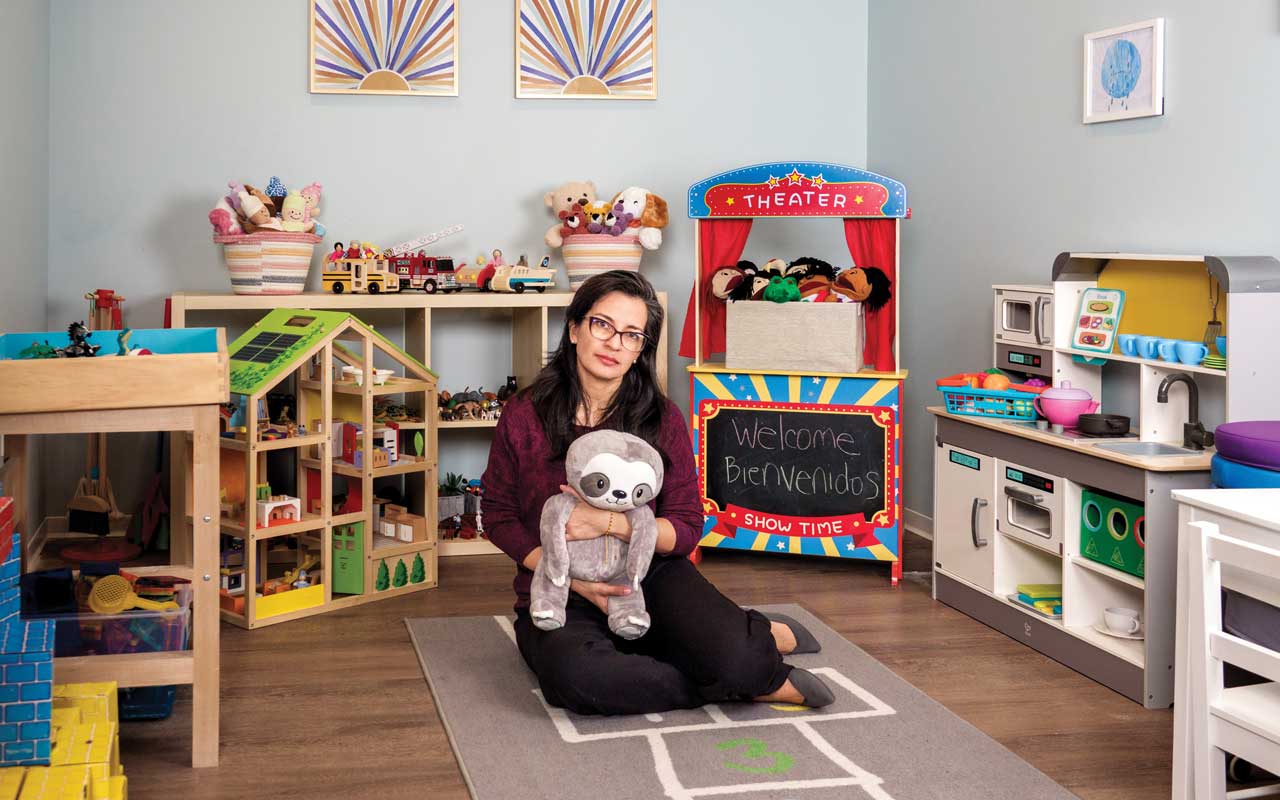
Ortiz says demand for Doorways’ shelter is at its highest level in the organization’s 47-year history. Some 150 individuals, mostly women and children, have come to the nonprofit seeking refuge in the past year. That’s more than double the number five years ago.
“Communities that are historically under-resourced or underserved tend to be the first ones…impacted when major national policy changes happen,” Ortiz says. “The first ones that are already stretched thin are the first ones that also suffer.”
Calls to Doorways’ 24-hour hotline have surged, too. Ortiz likens it to a hospital emergency room, with operators constantly triaging individuals in crisis. Every interaction matters. “You need that service right when you need it,” she says. “If we’re full, that means someone on the other [end] of the phone will have a harder time accessing services. And that…can cost us lives.”
‘We Can’t Take More Risk’
Nonprofits whose funding pies include a large slice of federal dollars are particularly vulnerable. Doorways relies on both public and private funding, deriving about half of its operating budget from federal, state and local grants. In June, the organization’s Covid relief funds expired. In September, Ortiz was waiting to hear whether a U.S. Department of Housing and Urban Development (HUD) grant that accounts for about 20% of her budget would be renewed.
In the interim, Doorways has shifted funds from private donations and cut staff to help cover the rent for clients in its permanent housing program. In August, Ortiz estimated having the resources to keep that going for about six months. For now, they are unable to move any new clients in their temporary shelter into permanent housing.
“There is a direct impact in how quickly people can get stabilized, how quickly people can really move out from an emergency,” she says. “We cannot take more risk. We wouldn’t want to evict anyone.”
Meanwhile, donations have dropped off. This year marks the first time Doorways has fallen short of meeting its private funding goals since the pre-pandemic era. Ortiz says federal layoffs have left some regular donors making “tough decisions” and reassessing their capacity to give.
The nonprofit has also lost volunteers who are suddenly out of work and refocusing their time on job searches. About a fifth of Doorway’s volunteers, including those manning the crisis hotline and providing childcare assistance for survivors, work (or worked) as federal employees or contractors.
Ortiz nevertheless underscores that her organization’s “doors are open” to anyone who needs help. They’d never want to turn someone away. “We are doing everything in our power to stay resilient and creative,” she says.
Funding Hangs in the Balance
Culpepper Garden, a 50-year-old Arlington retirement community for low-income seniors, is almost entirely funded by HUD money. As of September, its three independent living buildings on a 4.2 acre campus near Ballston were at capacity, home to about 350 residents. “We don’t know what HUD’s going to do,” says Executive Director Marta Hill Gray, “and we can’t really make any assumptions.”
As with other nonprofits, Gray has found strength in community. She keeps in touch with similar affordable housing entities across the country, sharing information and ideas via weekly phone calls. She says everyone is scrambling to develop contingency plans in the event that more federal funding cuts come to pass.
The threat alone has left many Culpepper residents in a state of panic. “We have people at the end of the month who have to decide if they spend the money for a cab to go to the doctor, or do they spend it on their medication, or do they buy food?” Gray says.
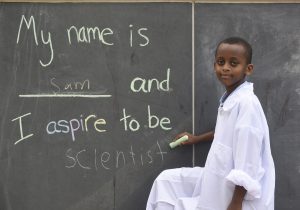
Aspire, a nonprofit provider of free afterschool and summer enrichment programs for low-income Arlington families, is also heavily reliant on federal funds. In April, the organization lost nearly a third of its budget when AmeriCorps grant funding was slashed by 41%. (Some federal funds were later reinstated, but the fate of the national program remains in limbo.) Seemingly overnight, the nonprofit lost all of its teachers.
“The day that I had to tell all the AmeriCorps members what happened was maybe one of the hardest days of my professional career,” says Aspire CEO and Executive Director Paula Fynboh. Each teacher agreed to stay on for the remainder of the week while Fynboh’s team strategized how to scrape together stopgap funding.
In the end, an emergency fundraising campaign raised enough money in about 24 hours to hire back most of the teachers as contract workers. Arlington County also boosted an existing county grant by an additional $16,600.
It didn’t help that Fynboh’s husband lost his job due to federal funding cuts that same month. She says her family took that setback in stride. “We’re going to be OK over the next few years because we have privilege,” she says. “That is not true for some of the students and the families we work with.”
Aspire’s enrollment has more than doubled in the past three years. In August, its fall waiting list was the longest in its history. The nonprofit continued its Rising Together fundraising campaign through the summer, receiving contributions from more than 300 donors. One donor is the mother of an Aspire student who gives what she can—$5 per month. Fynboh says many of the families Aspire supports have parents working two or three jobs to pay the bills.
“While [they are] are some of the most vulnerable in Arlington, they’re also incredibly hard-working,” she says.
Preparing for an Uncertain Future
As the federal budget battle for fiscal year 2026 plays out, PathForward is bracing for potential shortfalls. Public funding accounts for roughly 80% of its budget, and homelessness is on the rise.
“The Point in Time Count shows us that more people are not getting the help that they need, and they are finding themselves on the streets,” Frantz says.
“Now more than ever, we need individual donors and our community to step up. If we can get individuals housed, they have a really good chance of becoming stable in life. But unhoused? No.”
Recent efforts to clear homeless encampments in the District could leave nonprofits in neighboring jurisdictions even more strained for resources if displaced individuals decide to relocate. Arlington County officials say they have yet to see a measurable increase in unhoused people coming from D.C., but time will tell.
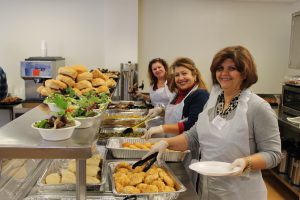
As Arlington’s social service providers scramble for stability, the atmosphere is tense. Nonprofit leaders say they can’t help worrying that more upheaval may lie ahead.
“What keeps me up at night? It’s the lack of predictability and inability to plan,” Frantz says. “There are so many different scenarios; I don’t spend my time worrying about any one specific scenario. What I do spend my time on is making sure we’re financially sound, and that’s where the community can really come in to support us.”
Stronger Together
PathForward and other nonprofits are in constant contact with one another for support and to share resources.
Interconnectedness is part of AFAC’s blueprint. “We’re all serving, in one way or another, the same population,” Meng says. More than 30 organizations have the ability to refer clients to AFAC for food assistance. In addition to serving families directly, the food pantry provides groceries to other local organizations, including PathForward and Culpepper Garden. “We don’t use the word ‘no’ down here,” Meng says.
He and other nonprofit leaders meet regularly as members of the Arlington Nonprofit Collective, an informal group of dozens of social service organizations.
“We’re all supportive of one another; we all serve a lot of the same people or do similar work,” says Gray of Culpepper Garden. “We’re all looking to find ways to do more with less, and to really be engaged.”
Devanshi Patel, CEO of the Arlington-based Center for Youth and Family Advocacy (CYFA), has coordinated the work of the collective for the past two years, though she says its history goes back decades.
“This year, we are really leaning into how we can more effectively work together,” she says. “Things are changing very quickly. It’s going to require us to be…more proactive and resourceful and have more partnerships with one another.”
Nothing is off the table. Ideas they’ve kicked around include pooling money to leverage health care coverage or teaming up on grant applications. “We can do better together,” Patel says.
In recent years, members of the collective have banded together to petition the county board for additional funding around issues such as teen mental health. “We are the organizations that are closest to the people who have the lived experience,” Patel asserts.
County Manager Mark Schwartz, Arlington Public Schools Superintendent Francisco Duran and Arlington Department of Human Services (DHS) Director Anita Friedman have sat in on some of the meetings. “There’s really good public-private collaboration,” Patel says.
In March, the county announced $1.8 million in funding to 23 local nonprofits as part of its equity-focused RACE to Rebuilding Trust and Community grant program, launched in 2023.
Arlington DHS recently boosted its contracts with nonprofits tackling homelessness and intimate partner violence. “Arlington County continues to monitor decisions from the federal government for any potential impacts to the community, including area nonprofits,” says a DHS spokesperson.
Doorways partners with multiple nonprofits, including AFAC, PathForward and True Ground Housing Partners (formerly APAH). “While this is not a pandemic, there are lessons we all…learned from the pandemic that we’re applying once again,” Ortiz says. “We’re in constant communication because things are moving rapidly.”
Many organizations report that their level of collaboration has increased this year. “A lot of us in this nonprofit safety net…we’re serving the same families,” says Aspire’s Fynboh. “While there’s an increased need, I think there’s also increased camaraderie and a sense of community. Just working together differently and more creatively to find solutions.”
Aspire is now partnering with Bridges to Independence, a local nonprofit providing emergency shelter, housing assistance and other services to low-income families. Together, the two organizations are developing a workforce readiness program that will recruit young adults for roles in Aspire classrooms. It’s a win-win, Fynboh says. Aspire students will receive more hands-on attention, and the classroom experience will help prepare those recruits for education and childcare jobs in the community.
Arlington Free Clinic similarly serves as a “training ground” for the medical students who volunteer there. “We’re contributing to the safety net in not only providing direct services, but also in raising up a new generation of service providers,” Daigle says.
‘Every Little Bit Makes a Difference’
With Giving Tuesday and the holiday season just around the corner, nonprofit execs are hoping for a year-end boost in donations as Arlingtonians round out their charitable giving and take advantage of end-of-year tax incentives.
The county government is also stepping in. In April, the Arlington County Board added $11 million to a stabilization fund—in part to help offset shortfalls in federal funding—bringing the fund’s total to $32.5 million. Arlington county has about $40 million in federal contracts for human services, says ACF’s Marroquín, who also serves as chair of the county’s Social Services Advisory Board.
While no amount of individual giving will close the gap, Marroquín stresses that every little bit makes a difference. “It’s important to not let that overwhelming feeling prevent action. It shouldn’t be paralysis by analysis.”
In this climate, agility is an asset. Frantz of PathForward says safety net providers are pivoting as best they can to accommodate as many clients as possible.
“We live in a very compassionate community, and I think we have a very compassionate county government,” she says. “Trying to do what’s best for human life has always been our primary focus. Our focus is to help those in need.”
Eliza Tebo is a freelance writer covering education, arts and culture in the D.C. area.
